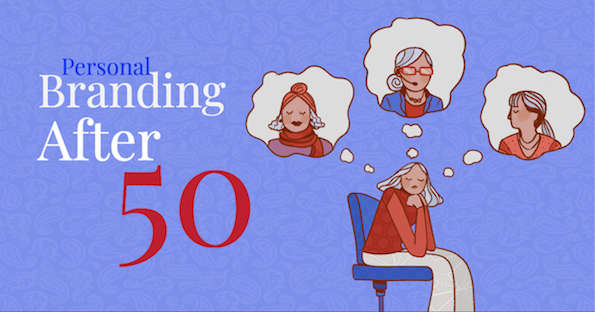By Debra Yearwood
Showing your best and letting your experience shine seems like a natural part of being engaged in your career, yet many older adults have told me they find personal branding difficult. To them, it feels like showing off or bragging. Their reluctance is understandable when you consider that resumés used to be seen as private business documents. The idea that you would share your professional triumphs and ideas on a public forum such as LinkedIn was unheard of, largely because LinkedIn didn’t exist. Perhaps its not surprising then that when research is being done on attitudes towards personal branding by age, Boomers are often not even considered. Given that your chances of losing your job rise exponentially after fifty and retirement age is moving closer to 70, it’s certainly something that needs to change.
While external attitudes and modesty account for some of the challenges older adults face in the self-branding arena, a more elusive yet pervasive culprit might be self-directed ageism. Self-directed ageism acts as a limit on abilities. It tells you you are too old to try, too weak to make it or too out of date to be considered and it starts when we are in grade school. It can influence decision making and consequently impact the nature and effectiveness of personal branding. In 2018 a BMO study of women entrepreneurs identified ageism as one of the significant barriers to success, second only to money. A Top Sixty Over Sixty (T60) study of older adults interested in entrepreneurial pursuits found that participants believed age negatively impacted job opportunities. They pointed to the expectation of a shorter stay because retirement would be right around the corner, cheaper labour with younger, more inexperienced employees as reasons for this. As one participant described it, “When people compete for jobs, given the same set of qualifications, a younger person has the advantage.”
If you think the world doesn’t want you, you are more likely to hide who you are, question your abilities and experience self-doubt. A crisis of confidence is not conducive to effective personal branding. As the research shows, if you expect to fail, then you will.
Fortunately, the opposite is also true. When you operate with optimism things improve. Optimists are more likely to experience lower stress levels; be more patient, more resilient, more proactive and generally happier. They are also better at personal branding because they don’t live with the fear that comes with pessimism. Keep in mind that only 10% of happiness is a reflection of circumstances, while 40% is a consequence of intentional activity. If you’re wondering where the other 50% comes from, it’s genetic.
So before you even start to think about your personal brand, you need to think about your attitude. Are you ready to shine? To be found? To be engaged? Do you have the confidence to succeed? Human resource experts advise you to be yourself. If you’re hiding who you are and what you have accomplished, then you’re more likely to fail. Don’t let ageism, neither external nor internal limit your options.
The following are some ideas to keep in mind when building an age-proof personal brand.
Stay Current: Know what’s happening in your industry. Learn what’s trending, what makes people talk or what’s turning into a big flop. If everyone in your industry is talking about artificial intelligence, consider what that might mean for business. Look at the common themes that are showing up in job descriptions even if you’re not looking for a new job. If you don’t have the skills that are in demand, then it’s time for an upgrade. Life-long learning is the new norm and a successful way to future-proof your appeal as an employee.
Look at Your Appearance: Are you taking care of yourself? Are you exercising and eating well? Are you well-groomed? Like any brand, the visuals matter. This is not about running a marathon or dying your hair; it’s about your overall health and energy levels. Like it or not, people make decisions based on first impressions and the way you appear is tied to your sense of self.
Online Persona: Don’t forget about LinkedIn. Make sure your profile is up to date and includes a smiling photo. Place particular emphasis on your most recent experiences (10 – 15 years) and take a look at what others in similar positions are saying on their profiles. Don’t lose your personal style; be informed with what you learn from others. When you do update your LinkedIn profile, don’t treat it like a billboard; don’t post it and ignore it. Engage on LinkedIn. Join groups, comment on or share articles of interest. You don’t have to do this every day, but don’t let your profile go silent for weeks on end either.
Consider Your Thoughts: Are you inadvertently undermining your own efforts? T60 research found that in the process of describing “old”, people over 50 primarily used negative words such as “weak, painful, slow-moving”. Don’t let these negative ideas become part of how you look at yourself. Your profile is the wrong spot for self-deprecating humour. Stay positive, you’re more likely to attract people. No one wants to hang out with a Debbie Downer.
Be Yourself: Regardless of age, this is good advice. The best personal brand is based on your values, strengths and aspirations. If you want to stand out in the crowd, convey your unique value. Take the time to reflect on your greatest achievements. What makes you most proud? What skills have been consistent throughout your career and life? These are the backbone of your personal brand.
Debra Yearwood is a professional communicator and the COO of Top Sixty Over Sixty (T60 Strategies), a social enterprise that offers thought leadership, consulting and training on age inclusion.
Sources
- Everywhere Every Day Innovating
- Impact of the ReSet Program on Internalized Feelings of Ageism
- Ageism and the Older Worker
Related Articles:

